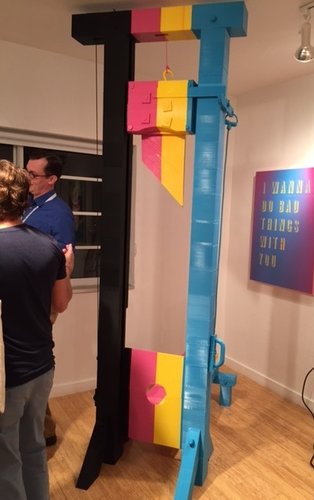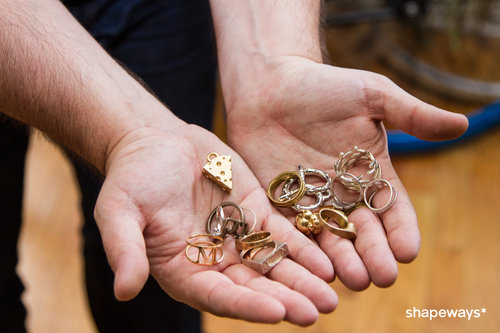by Carolyn Edlund
Are you using high tech to boost productivity and increase your options in the studio?

Guillotine made with 3D printing technology by artist Nathan Sharratt, student at Ernest G. Welch School of Art & Design, Georgia State University. Displayed at Aqua Art Miami, 2015
I’ve long been fascinated with 3D printing, and how this quickly evolving technology can be used creatively by artists. I contacted Avi Reichental, TED Talk speaker and founder of Xponential Works who is a nationally known expert on the subject for more information on how it works. He suggests using the term “digital fabrication” which is more comprehensive, and includes a host of technologies that are both additive (such as 3D printing) and subtractive (think CNC routing and laser cutting).
Do these processes sound like foreign concepts? They may not be the first techniques you consider when making your art. However, technology continues to develop more ways to create faster and better. These tools will soon be so widespread and accepted that artists may readily gravitate to them in their creative practice.
What does digital fabrication do? How can an entrepreneur, specifically a visual artist, embrace the technology at this time?
“Artists can design in 3D using a variety of mediums,” said Reichental. “There are almost 100 mediums to choose from, including plastics, metal, wood/polymer, paper, and even food. These require the artist to become familiar with the sculpting software that is required for the printing process. Secondly, the artist should know how to scan existing art through 3D scanning devices.”
The range of print capabilities is growing to include printing in multi-color, he explains. This will produce pieces that range from being rigid to very elastic.
“Your ideas and designs can be produced by third party on demand service bureaus, or you might consider investing in a 3D printer yourself,” he adds. “It can be useful as a learning tool considering that at this time simple printers are available for as little as $300. This technology can be used for making prototypes either for larger artwork or for producing components.”
High Tech for the Studio
Elaborate 3D printers can range in price from $5,000 to $10,000. Therefore, Reichental suggests that artists collaborate or purchase the equipment for use by a group. Prices will drop as technology becomes more advanced and mainstream. One currently popular personal-sized printer is the GlowForge. Their range of 3D printing equipment has prices currently ranging from $2,495 – $5,995.

Jewelry components made using 3D printing by Shapeways
Even without equipment in your own studio, you have options. Design ideas can be created using 3D printing through a service such as Shapeways, which offers a huge range of options. Shapeways spokesperson Mansee Muzumdar describes their service as “print on demand” and explains that they can be used as a manufacturer of component parts that the artist will use in projects. And, they also offer e-commerce through a marketplace that sells 3D printed goods for the artist if they desire.
“Creating component parts is a large part of what we do,” she says. “About 40% of the print-on-demand work that we do is sold in the online marketplace and 60% is private work.”
Shapeways also frequently produces prototypes for artists, for example in jewelry designs. The model is first built in plastic, and is ready for approval by the artist. This saves a considerable amount on materials costs. After approval is given, the provider can produce in precious metals or whatever else is required. This becomes a super efficient process for artists who are looking to make customized designs.
Have you ever used “digital fabrication” in your own studio practice for producing finished work or components? What techniques do you employ?


Thanks Carolyn for this informative article. I have been investigating 3D printing technology this week. The timing of this is perfect!
Hi Kathy, Check back in next Tuesday, because we will be sharing specific examples of how artists we know are using 3D printing in their own studios!
This was a great article Carolyn. I use 3d printing in 2 of my businesses and it has become our go to design options and we have been able to expand both companies. We use resin, plastic and wax. I hope to see it expand even more in the future.
It’s a great way to leverage your designs and make them in production, so I can easily see why this allows you to expand. This type of efficiency makes for faster turnaround, and higher profit margins!